Library of Congress's Blog, page 190
March 23, 2012
Tweeting Live: Stress and Its Impacts
We all have dealt with stress at one time or another – whether it's the demands of work, family responsibilities, day-to-day hassles of life or all of the above. Frankly, for many people, being "stressed out" is just part of their regular routine.
According to Dr. George Chrousos, chairman of the Department of Pediatrics at the Athens University Medical School in Greece and a professor at Georgetown University Medical School, stress plays a sizeable role in a person's health and in society, often triggering such psychosocial factors as addiction, obesity and poverty.
The Library's John W. Kluge Center is presenting a two-day conference, "The Profound Impact of Stress: Human Biology and Social Implications for the Individual and Society," next week on March 26-27. At the conference, experts will discuss the information emerging from the most recent biomedical research. They will also present research on the interrelationship of social conditions and human health and what might be done to mitigate the effects of stress.
We will be live-tweeting both days, starting at 8:30 a.m. Follow us on Twitter, @LibraryCongress and use the hashtags #stressimpact #klugectr to see the latest in stress research and join the conversation.
If you're in town and able to attend the conference, it will be held in Room 119 of the Thomas Jefferson Building. Don't forget to add the hashtags to your tweets so you can also be part of the event.
The complete speakers list and agenda may be found here.
March 21, 2012
The Year of the Girl
I have a pack of Thin Mint Girl Scout cookies in my freezer. I treat myself to one or two occasionally, although it's hard limiting myself since you really can't eat just a couple. I can't buy Samoas anymore because I won't stop until I eat the whole box.
While we may be enjoying the beginnings of spring, Girl Scout cookie season is also upon us. And, while many of us will happily succumb to the guilty pleasure, these are cookies with a cause. According to the Girl Scouts, "every cookie has a mission," from teaching girls how to manage money, to supporting our overseas troops, to funding a camp for city kids.
As you dig into your favorite box this month, you'll also be celebrating the 100th anniversary of Girl Scouts of the USA. On March 12, 1912, Juliette "Daisy" Gordon Low gathered 18 girls from Savannah, Ga., for the very first troop meeting. Since then, the organization has grown to include more than 3 million young women and adults. Some of our nation's most notable women have roots in the organization: Secretary of State Hillary Clinton, astronaut Sally Ride and former first lady and National Book Festival chair Laura Bush.
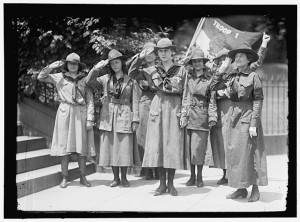
Girl Scouts Troop #1 with founder Juliette Low, right. 1917/Prints and Photographs Division
The Library's online photograph collections are a wealth of interesting Girl Scout-related items, including images of troop members engaging in a variety of activities and spending time with first ladies.
While I myself never made it past Brownie status, you can't help but be inspired by the enthusiasm of the organization's membership. A quick scan of the news in recent days reveals stories about girls organizing a museum exhibition, collecting donations to send some 2,700 boxes of cookies to troops stationed overseas and working with a local humane society to collect food and other items.
You can also peruse historic newspaper collection to see what the Girl Scouts of yesteryear were up to.
March 20, 2012
Take Those Comics Seriously!
Comics and cartoons are well-loved because they're funny. Most of us think of them as a break in the monotony of a working day, a light moment, a chuckle over our morning coffee.
But for some, mirth is money. Those people tend to take their comics more seriously.
Take, for example, the reaction to "The Yellow Kid" drawn by Richard Outcault in his "Hogan's Alley," one of the first comic strips in the U.S., which emerged during the New York newspaper wars around the turn of the last century. Here's the Yellow Kid in his characteristic baggy yellow garment.
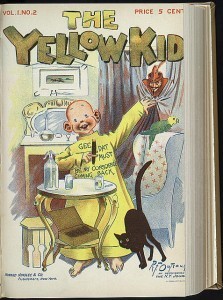
Hearst's competitors hated "The Yellow Kid"
The Library of Congress has many editions of early newspapers in its "Chronicling America" online collection and examples of early newspaper comic supplements in its Prints & Photographs online catalog, where this item was found.
In "Park Row," Allen Churchill's book about the newspaper wars between moguls Joseph Pulitzer and William Randolph Hearst, he notes that "New York went wild" over Hearst's "Yellow Kid," although writers from competing papers disparaged the character.
Quoting Max Nordau, Churchill wrote: 'The Yellow Kid is the exact and ultimate expression of degeneracy. Notice the bald head (on a boy), the two teeth, the abnormal head and abnormal feet, the formless shirt of yellow – color of decay.'"
Comic strips and kids will be also be the subject of a talk at noon on Thursday, March 29 in the Library's James Madison Building Dining Room A. In "Sketching the Secret Tracts of the Child's Mind: Theorizing Childhood in Early American Fantasy Strips," Lara Saguisag will discuss her research at the Library into such comics as "Little Nemo in Slumberland" and "Wee Willie Winkie's World."
Of course we still value a good cartoon today – what would The New Yorker magazine, or your favorite newspaper (or graphic novel) be without them?
And newspaper wars over cartoons are not quite yet submerged in the mists of time.
Consider this photo, taken late in 1989 in Denver. It records a caper carried out by five pranksters from the Denver Post staff, showing what they thought about the Rocky Mountain News taking the comic strip "Garfield" away from the Post and then rubbing it in through a Christmas display. (Thanks to John Leyba – prankster No. 5 — for the photo.)
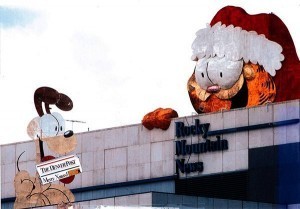
The Great Garfield Caper
March 19, 2012
Full of Hot Air
A bat in the belfry? Maybe. A tree growing in Brooklyn? Sure. A light in the attic? Of course. But, a dirigible in the Library's Jefferson Building? It happened.
Walking the institution's resplendent halls, you come across lovely murals, elaborate ornamentation, gilded embellishments, and, as it turned out the other day, two rather large balloons – mini dirigibles in fact.
So, what were they doing? The balloons in question were floating about on March to film scenes for a project by artist Isabella Streffen, who was a visiting British Research Council Fellow at the Library's John W. Kluge Center last year. Her project, titled "Hawk & Dove," is a film using footage shot from two seven-foot remote-controlled zeppelins (the Hawk and the Dove) that moved around both the Library of Congress and the Martin Luther King, Jr. Memorial Library in a "balletic dogfight" to "explore the role of knowledge in the shaping of political debate."

Isabella Streffen with her two dirigibles, the Hawk and the Dove./Richard Hollinshead
Streffen's film developed directly out of her six-month Kluge Center residency, where she researched the early history of ballooning and military visioning in the Library's Gaston and Albert Tissandier archive. She was also inspired by the unexpected residency of "Shirley," our rather famous Cooper's Hawk who camped out in the Library's Main Reading Room while Streffen was doing her research.
"Hawk & Dove" debuts as part of the 5×5 Project, which is exhibiting 25 ground-breaking public art installations created by artists from around the world as part of D.C.'s National Cherry Blossom Festival Centennial celebration. More information on the project, sponsored by the DC Commission on the Arts and Humanities, can be found here.
Streffen's film will be screened at the Library of Congress on April 24 at noon in the Whittall Pavilion and at the Martin Luther King, Jr. Memorial Library April 26-28.
The Library is also part of the larger Cherry Blossom Centennial celebration, which you can read bout in this previous blog post.
March 15, 2012
Pic of the Week: A Simple Sunset
O setting sun! though the time has come,
I still warble under you, if none else does, unmitigated adoration.
~ Walt Whitman, "Song at Sunset"
This picture was taken from the sixth floor balcony of the James Madison Building recently, as the sun set over Washington, D.C., bathing the sky in a lovely peach hue. Frankly, it has me longing for the spring and perhaps enjoying this time of day al fresco, particularly as the weather here of late has been perfect for such a thing .
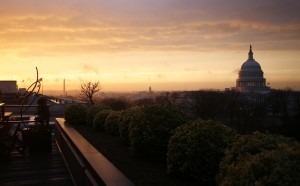
Sunset from the balcony of the Madison Building./Abby Brack
I have to admit that I wasn't familiar with the above poem by Whitman poem and just so happened to run across it the other day. But it is fitting don't you think? Looking at the picture certainly does give that sense of wonder and amazement that the Good Gray Poet puts into verse.
This particular poem is part of Whitman's larger work, "Leaves of Grass." The Library houses the largest archival collection of Walt Whitman materials in the world, including several editions of his seminal work, as Whitman revised the compendium many times over the course of his life.
March 12, 2012
Unlocking Sounds of the Past
You may recall reading about some early audio recordings of Alexander Graham Bell being recently recovered. Thanks to Library of Congress technology, these recordings and others can now have a new life. The following is a story by Mark Hartsell, editor of the Library's newsletter, The Gazette, on how the institution is working to accomplish this.
In the basement of the Madison Building, Peter Alyea sits at a desk and takes millions of photos of the insides of the grooves of old recordings.
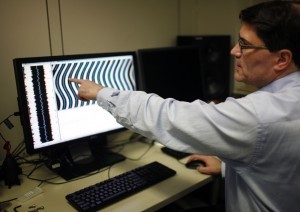
Peter Alyea displays a digital image of the grooves of an old recordings captured by IRENE./Abby Brack Lewis
The images, reassembled on Alyea's computer monitor, reveal in detail every curve cut into the floor of every groove – and provide the key to extracting sound from recordings unheard for decades and preserving those sounds for future generations.
The pictures are the product of IRENE/3-D, a system that uses digital imaging to retrieve sound from historical recordings made on discs and cylinders that might otherwise be unplayable.
IRENE allows damaged recordings – a disc broken into separate pieces, for example – to be reassembled digitally and for the sonic debris of pops, skips and distortions to be cleared away just as a technician might Photoshop a blemish from a photograph.
Over the past year, Alyea, a digital-conversion specialist at the Library of Congress, served on a multi-institution team of scientists and curators that used IRENE at the Library to extract sound from some of the oldest recordings ever made – a group of experimental discs produced by Alexander Graham Bell whose contents hadn't been heard since they were made about 125 years ago.
The work is important to preserving the nation's sonic cultural heritage.
A study released by the Library in 2010 found that major areas of America's recorded sound heritage already have deteriorated or remain inaccessible to the public.
Most audio formats deteriorate over time: Discs warps, and both discs and cylinders break or degrade.
That's where IRENE steps in.
"We know they're going to fall apart, and there are things you can do to increase longevity," Alyea said. "But we know they will go away, and we want to get the information off of them."
IRENE is Born
The idea for IRENE was conceived when Carl Haber and Vitaliy Fadeyev, scientists at the Lawrence Berkeley National Laboratory in California, heard Grateful Dead drummer Mickey Hart discuss on a radio program the loss of cultural heritage through the chemical breakdown of recordings.
Why, they wondered, couldn't we just make high-resolution images of a disc and use the pictures to extract the data embedded in the grooves? Why couldn't software then convert that data into sound?
Haber and Fadayev experimented with the idea over 2003 and '04. Eventually, a workable system was born and named IRENE – after the first record from which they managed to extract sound, "Goodnight, Irene" by the Weavers.
(The name then was reverse-engineered into an acronym: "Image, Reconstruct, Erase Noise, Etc.")
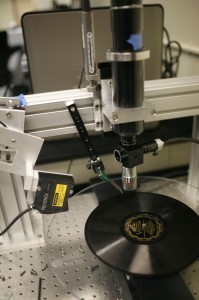
IRENE uses high-resolution cameras to capture images of the grooves of recordings. Software then converts those images into sound./Abby Brack Lewis
With IRENE, a light shined onto a disc or cylinder reflects into a high-resolution camera mounted overhead. The camera makes images of the lateral motion of the groove – more than 2 million images for a typical 78 rpm recording. Software analyzes the motion of the grooves shown in those images, then converts the data into sound.
The system also helps preserve fragile historic material: Because a camera reads the grooves of a recording, the delicate discs are spared the wear inflicted by repeated physical contact of a stylus.
Alyea read a report about Haber and Fadeyev's work and had his own eureka moment: He realized the approach could be used to extract sound from broken discs and that IRENE could be automated to produce digital copies of recordings in large numbers.
"All these things suddenly flew into my head when I read what they were saying," Alyea said.
Alyea and Haber discussed the possibility of a collaboration between Berkeley and the Library, and the first device – fabricated at the lab – was installed at the Library in 2006. The original 2-D system later was installed at the Library's Culpeper facility and a second 2-D/3-D version – better at reading the grooves of cylinder recordings – was installed at the Madison Building in 2009.
'Ba-ro-me-ter, ba-ro-me-ter'
Over the past year, Alyea, Haber, Berkeley scientist Earl Cornell and Shari Stout and Carlene Stephens, curators from the Smithsonian Institution, worked at the Library to retrieve sound from a group of experimental recordings made by Bell at a Washington, D.C., laboratory about 125 years ago.
In the 1880s, recorded sound was a hot field of invention, and competition was intense among great innovators such as Bell, Thomas Edison and Emile Berliner.
Bell and his colleagues at the Volta Laboratory in the District tried many techniques and media to record sound: tin and wax cylinders; discs of metal, glass, plaster and paper; a tape of wax-coated paper strips wrapped around two reels – kind of a primitive tape recorder.
"Bell was working in this highly competitive, highly lucrative field of high-technology communications, much as people are expanding those boundaries today," said Stephens, a curator at the Smithsonian's National Museum of American History.
To protect himself against potential claims against his patents, Bell later sealed those experimental recordings – along with his lab notes and evidence of date, such as newspapers – in tin boxes and deposited them for safekeeping at the Smithsonian. He much later gave about 200 more of the recordings to the Smithsonian.
For decades, the recordings sat mostly untouched – and entirely unheard.
"Because the recordings were considered unplayable, they were placed in a remote part of the storage room and nobody was using them for research, for sound, for anything," Stephens said.
In 2008, Stephens read about the Library's work with sound recovery and contacted Library officials to discuss a joint project to extract sound from the Bell recordings.
The project team chose six recordings – deemed most likely to yield sound – to submit to IRENE.
"These are one-offs," Stephens said. "They are recordings before a standard style of medium and recording technique was developed. Each one needs special attention. Each one is fragile."
The team eventually was able to extract sound from each of the six recordings.
A recording made on a brass disc covered with wax yielded a recitation from "Hamlet." A glass photodisc features the word "ba-ro-me-ter" enunciated over and over. Another glass disc yielded trilling, the date of the recording (March 11, 1885) and "Mary had a Little Lamb."
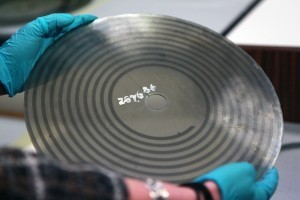
This large glass photodisc contained the word "barometer" repeated over and over./Abby Brack Lewis
"It made the hair stand up on the back of my neck," Stephens said. "It was so thrilling. It was so eerie. It was so much a glimpse into a time period we have never heard from before, ever."
Saving 78s
With IRENE, the Library wanted not just a tool that could "play" previously unplayable recordings, but also a fairly automated system that would allow technicians to conduct a high-volume transfer of 78-rpm recordings to digital files without time-intensive work by operators.
"The model of being able to make fast copies non-invasively with staff not specifically trained to know all the ins and outs of audio engineering was very attractive," Alyea said.
The goal was to produce in large numbers digital audio files that could be used for access and, in the best case, preservation – and eliminate the need to ever play a disc again.
That's been a challenge: Recordings come in many different formats, shapes and sizes, and the set-up and software frequently would need tweaking to accommodate the multitude of types.
But technicians have succeeded in producing sound files good enough to provide the public access to the material without an engineer spending a lot of time on each recording: The system has been used to make digital copies of hundreds of rare recordings from the Library collections.
"It proved to be even more reliable than I thought it would be," Alyea said. "I actually thought it would have more problems. They basically have no problems with the capture side."
The work of extracting sound from the Smithsonian material presented the opposite idea: The set-up and software frequently were modified to suit individual discs or cylinders.
The reward, however, is to give listeners the opportunity to hear recordings that otherwise might never have been heard again.
"The prospect of being able to save these recordings, save the sound heritage, save the sound culture of civilizations all around the world is pretty exciting," Stephens said.
More information about the Bell recordings – and clips of sound extracted from them – can be found here.
More information about IRENE is available here.
March 8, 2012
Straight to Your Inbox
Almost everything the Library of Congress does, you can get an email about it. And, no, I'm not making a "Portlandia" reference either. From our potpourri of services to general news to topic specific information – even this blog – you can be only one click away from the latest updates the institution has to offer.
If you haven't done so already, make sure to sign up for our email subscription service here so you won't miss a beat. This is just another of our continual efforts to get information out there in the most useful way possible.
March 6, 2012
Lobbying for the Silver Screen
The following is a guest post by Brian Taves, senior cataloging specialist in the Library's Motion Picture, Broadcasting and Recorded Sound Division.
A new gift to the Library's Motion Picture, Broadcasting and Recorded Sound Division reminds us that movies are more than just the image on the screen and the sounds that accompany them. They are also the visit to the theater, and the advertising heralding the movie and the photos of scenes and stars.
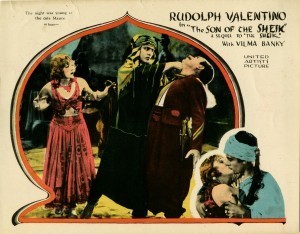
"Son of the Sheik" (1926)/Library of Congress
Many of these are just as common today as they were early in the 20th century; movie posters outside of theaters remain a way to lure possible patrons into a show. Also enduring are movie stills, showing scenes from the movie or its stars, or sometimes shots of the production, most typically used in press notices accompanying reviews. Other types of advertising art have nearly vanished, however, and among the most artistic of these were lobby cards.
Lobby cards were unique for combining the graphics created to accompany a movie with still images. The advertising art was usually presented stylistically around the borders, highlighting an inset photo. While stills themselves usually measured 8×10 and were primarily in black-and-white through the 1970s, lobby cards were most often in color, measured 11×14 inches and typically issued in sets of eight.
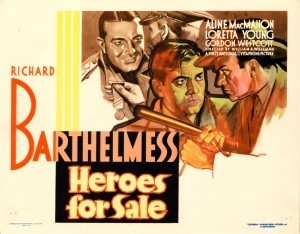
"Heroes for Sale" (1933)/Library of Congress
This standard form allowed many variables. Usually the inset scenes showed a highlight of the movie. Sometimes, however, they emphasized portraits of stars, especially when posed to highlight the on-screen love interest. The graphics created to promote the movie could be manipulated in many different ways, and sometimes each of the cards would have unique stylization in addition to the separate scene or star image.
The fact that lobby cards were in color, at a time when most of the movies (and stills from them) were in black-and-white, established the lobby card as a distinct medium for promotion. With both the drawn poster and the photograph blended into a single work, lobby cards often achieved a unique potential. The fact that, like the stills, lobby cards were small enough to be held gave lobby cards a more intimate relationship as relics of the movie.
From 1910 through the 1980s, lobby cards were distributed to theaters along with posters, stills and advertising. Usually theater owners were instructed to return them to movie distributors, for use in subsequent screenings, or to destroy them. Thus, most lobby cards, like posters, did not long survive their original printing.
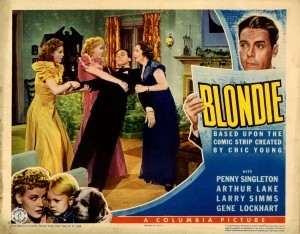
"Blondie" (1938)/Library of Congress
Lobby cards did have one advantage, however. Because of their size, they were printed on card stock rather than flimsy paper. Perhaps this, and their very colorful nature, allowed some to survive and to become a form of movie collectible.
In the 1950s, the Motion Picture, Broadcasting and Recorded Sound Division began to collect lobby cards and posters and to augment its collection of stills and pressbooks (the manuals given to theater owners upon booking a film with information on promotion) through an arrangement with National Screen Service. As supplier of such advertising to many studios, National Screen Service's warehouse had become packed with items likely never to be used again for movies that had been sold to television. For three decades, until National Screen Service's demise, the Library gained a treasure trove, documenting presentations about movies to theatergoers.

"The Black Pirate" (1926)/Library of Congress
Many donations have also helped to expand the division's lobby-card holdings. Recently, noted collector Dwight Cleveland, who had previously given an extraordinary collection of glass slides used to promote upcoming movies from about 1910 to the 1950s, has given the Library several hundred lobby cards from 1910 through the 1930s. Spanning many genres and stars, the collection serves to vividly illustrate the variety and artistic potential of lobby cards as a means of promotion.
March 1, 2012
Pretty in Pink
Soon all of Washington, D.C. will be blossom-crazy thanks to the upcoming National Cherry Blossom Festival – a signature event for the capital region – set for March 20 through April 27. This year, all the stops are being pulled out as the celebration marks the 100th anniversary of the gift of trees from Tokyo to Washington.
If you haven't yet had the chance to see the blossoms, you should. The formation of trees around the Tidal Basin is quite magical. It's like walking amidst clouds of pink and white. As the petals shed, you have nature's perfect confetti.

Washington Monument, Washington, D.C., April 2, 2007. Photo by Carol M. Highsmith. Prints & Photographs Division.
At the annual news conference held this morning at the Newseum, organizers highlighted the bevy of festival-related programming. The morning's big announcement: Chief Horticulturalist of the National Park Service, Robert DeFeo, predicted the cherry blossoms will peak this year between March 24 and March 31. Official events include a fireworks display on April 7 and the Japanese street festival and annual parade on April 14. More information can be found at the festival's official website.
The Library of Congress is also celebrating the milestone with an exhibition titled "Sakura: Cherry Blossoms as Living Symbols of Friendship," opening on Tuesday, March 20, in the Graphic Arts Galleries on the ground floor of the Thomas Jefferson Building, 10 First St. S.E., Washington, D.C. The exhibition runs through Saturday, Sept. 15, 2012. More information can be found here.
Additional free events at the Library will include a series of gallery talks on the exhibition, a lecture by former Ambassador John Malott on the 1912 gift of the flowering cherry trees and an event for children, "Japanese Culture Day." Here is a full listing of the Library's related programming.
February 29, 2012
To Borrow From Google … and Rossini … and the Cosmos
What do leaping frogs and composer Gioachino Rossini have in common? Well, thanks to today's Google doodle the two are brought together rather comically – not only does today mark the cosmic anomaly of leap day but it's also the 220th birthday of Rossini … or his 53rd, depending upon which way you roll.
After some Googling of my own, it would appear the frogs – who have made previous leaping appearances in the search engine's doodle – are paying tribute to "The Barber of Seville," Rossini's famous 1816 comic opera and also one of the most-performed on stage.
The Library's own National Jukebox has pulled together more than 50 selections of Rossini's compositions, including several from the noted opera. In addition, the Library's collections include several pieces of sheet music, including this one for piano, titled "Barbier de Seville," op. 36.
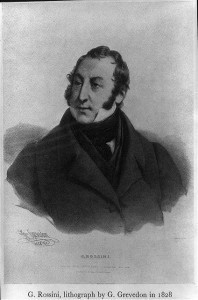
Prints and Photographs Division/Library of Congress
Rossini was born on Feb. 29, 1792, in Pesaro, Italy. He has works listed as early as 1801. At 12, he delivered a set of six sonatas for strings, which scholars actually discovered the original scores in the Library of Congress following World War II. Rossini's other famous operas include "William Tell" (1829), "Semiramide" (1823) and "Cinderella" (1817). He died Nov. 13, 1868.
According to statistics, the probability of a birthday falling on leap day is 1 in 1461. To put another number on it, that means nearly 5 million people worldwide are "leapers." Now, whether they celebrate on Feb. 28 or March 1 on non-leap years is a matter of personal preference. Personally, I'd celebrate both days for double the gifts and fun! Of course, I'd likely only officially mark the event in accordance with the leap calendar … you know, to stay younger longer.
Library of Congress's Blog
- Library of Congress's profile
- 74 followers



